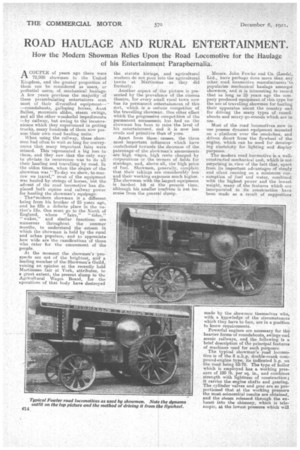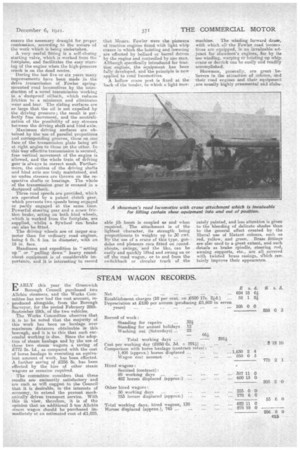ROAD HAULAGE AND RURAL ENTERTAINMENT.
Page 10

Page 11

If you've noticed an error in this article please click here to report it so we can fix it.
How the Modern Showman Relies Upo of his Entertainm
ACOUPLE of years ago there were 72,000 showmen in the United Kingdom, and the greater proportion of them can be considered as users, or potential users, of, mechanical haulageA few years previous the majority of these perambulating entertainers sent most of their diversified equipment— .—roundabouts, galloping horses, Aunt Sallies, mountain slides, steam swings, and all the other wonderful impedimenta .—by railway, but Owing to the inconvenience which they experienced in getting trucks, many hundreds of them now possess their own road hauling units.
When using the railway, these showmen had often to wait so long for conveyances that many important fairs were missed. This represented a big loss to them, and they saw that the only way to obviate its recurrence was to do all their hauling and travelling by road. In the olden times, when the slogan of the showman was "To-day we show, to-morrow we travel;" most of the equipment was hauled by strings of horses, but the advent of the road locomotive has displaced both equine and railway power for hauling the showman's equipage.
Themedern showman is a different being from his brother of 25 sears ago, and he fills a. definite place in the nation's life. One must go to the North of England, where "fairs," " tides," "wakes," and similar functions are numerous throughout the summer months, to understand the esteem in which the showman is held by the rural and urban pep-Once,and to appreciate how wide are the ramifications of those who cater for the amusement. of the people.
At the moment the showmen's 'prospects are not of the brightest, and a leading member of the Showmen's Guild, voicing an opinion at the recently held Martinmas fair at York, attributes, to a great extent, the present slump to the Agricultural Wages Board, for the operations of that body have destroyed the statute hirings and agricultural workers do not pour nto the agricultural towns at Martin as as they did I ornherly.
Another aspect of the picture is presented by the preys, lice of the cinema theatre, for every s all rural town now has its permanent e tertaitunent of this Sort, which, is a -s• ious competitor of the travelling showm n. One other effect which the progressiv competition of the permanent amuseme t has had on the showman has been raise the level of his entertainment, id it is now less crude and primitive an of yore.
Apart from these causes, the three most important ind ences which bays contributed towards he decrease of the patronage' of the showman's amusements are high wages, high rents charged by corporations or the wners of fields for standage, and, above all, the high price of fuel. Showmen, enerally, complain that their takings a e considerably less and their working ex ensure much higher. The showman with th largest equipment is hardest hit at he present time, although his smaller onfrere is net immune from the gene I slump.
Messrs. John Fowler end Co. (Leeds), Ltd., have perhaps done more than any other road locomotive manufactureis popularize mechanical haulage amongst showmen and it is interesting to record that as long as 25 years ago the company produced equipment of this type for the use of travelling showmen for hauling their apparatus about the country and for driving the many types of • roundabouts and Merry-go-rounds which are in Use.
Most of the road locomotives now in use possess dynamo equipment mounted on za• platform over the smokeliox, and driven direct from the flywheel of the engine, which can be used for developing electricity for lighting and display purposes.
The modern road locomotive is a wellconstructed mechanical unit, which is not surprising insview of the fact that, apart from its important advantages of steady and silent running on a minimum consumption of fuel and water, combined with the highest power and the lowest weight, many of the features which are incorporated in its construction have been made as a result of suggestions'
made by the showmen themselves who, with a knowledge of the cirenmstances which they have to face, are in a position to know requirements.
Powerful engines are necessary for they' heavier forms of roundabouts, swings.and scenic railways, and the following is a brief description of the principal features of machines used fctr such purposes.
The typical showman's road locomotive is of the 8 n.h.p double-crank compound-engine type, its indicated h.p. on the road being 62-78. The type of boiler which is employed has a working pressure of 180 lb. per sq. in., and combines strength with lightness of construction; it carries the engine shafts and gearing. The cylinder valves and gear are so proportioned that at the working pressure the most eebnomical results are obtained, and the steam released through the exhaust into the chimney, which is telescopic. at the lowest pressure which will
ensure the necessary draught for proper combustion, according to the nature of the work which is being undertaken.
A very useful fitting is a self-closing starting valve which is worked from the footplate, and! facilitates the easy starting of the engine when the high-pressure crank is on the dead centre.
During the last five or six years many improvements have been made in the drive transmission of Fowler springmounted road locomotives by. the introduction of a novel transmission working in a,' dustproof oilbath, which reduces friction to a minimum and eliminates wear and tear, The sliding surfaces are so large that the oil is not expelled by the driving pressure; the result is perfectly free movement, and the neutralization of the possibility of any stresses between the driving shaft and hind axle. Maximum driving surfaces are obtained by the use of parallel projections and corresponding grooves, these on one face of the transmission plate being set at right angles to those on the other. In this way effective transmission is secured, free vertical movement of the engine is allowed, and the whole train of driving gear is always in correct mesh. Furthermore, the centres of the driving shafts and hind axle are truly maintained, and no undue stresses are thrown on the respective shafts or bearings. The whole of the transmission gear is encased in a .dustproof oilbath.
Three road speeds are provided, which are operated by a, patent clutch gear, which prevents two speeds being engaged or partly engaged at the same time. Powerful steering gear and a screw friction brake, acting on both hind wheels, which is Worked from the footplate, are supplied, •whilst a flywheel run brake can also be fitted.
The driving wheels are at larger one meter than for ordinary road engines, being 6 ft. 6 ins, in diameter, with an 18 in face.
Handiness and expedition in "setting up" or "pulling down" heavy roundabout equipment is of considerable importande, and it is interesting to record
EARLY this year the Greenwich Borough Council purchased two Allchin steamers and the Works Committee has now had the cost account, reproduced alongside, from the Borough Surveyor, for the period February 28thSeptember 29th, of the two vehicles.
The Works. Committee observes that it is to be noted that the majority of this work has been on haulage over maximum distances obtainable in this borough, and it is to this that such successful working is due. Since the adoption of steam haulage and by the use of these two steam wagons a saving of £772 2s, 1d,, as compared with the cost of horse haulage in executing an equivalent amount of work, has been effected. A further saving of £256 8s. has been effected by the hire of other steam wagons as occasion required.
The committee considers that these results are eminently satisfactory and are such as will suggest to the Council that it is desirable, in 'the interests of economy, to extend the present mealanirally driven transport service. With this in. view, therefore, it is of the opinion that an additional 5 ton Allchin steam wagon should be purchased immediately at an estimated cost of £1,025.
that Messrs. Fowler were the pioneers of traction engines fitted with light whip cranes in which the hoisting and lowering are effected by bollard or barrel driven by the engine and controlled by one man. Although specifically introduced for traction engines, the equipment has been fully developed, and the principle is now applied to road locomotives.
A hollow crane .post is fixed. at the back of the tender, to which a light mov
able jib boom is coupled as and when required. The attachment is of the lightest character, its strength being proportionate to weights up to 30 cwt. By the use of a crane of this type, gondolas and pleasure cars fitted on roundabouts, swings, and the like, can be easily and quickly lifted and swung on or off the road wagon,. or to and from the switchback or circular track of the machine. The winding forward drum, with which all the Fowler road locome• tires are equipped, is an invaluable adjunct for showmen's engines, for by its use winding, warping or hoisting up whip crane or derrick can be easily and readily accomplished.
Showmen, generally, are great 'believers in the attraction of colours, and their road engines and their equipment are usually highly ornamental and elabo
rately painted, and less attention is given to the blending of delicate shades than to the general effect created by the liberal use of blatant colours, such as red, yellow, and green. Brass fittings are also used to a great extent, and such details as brake spindle, steering rod, awning supports, etc., are all covered with twisted brass casings, wThich certainly improve their appearance.
































